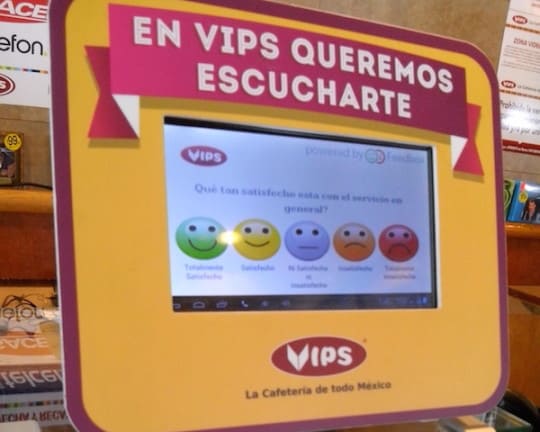Mark's note: Today's guest post is by Rodrigo Bernal, with the first post on this site contributed from Mexico. Rodrigo uses a lunch outing to raise important questions about customer focus and the voice of the customer. If there is a quality problem, does that feedback get back to the source of the problem for root cause analysis and corrective action? If you're asking customers for feedback, is it superficial or meaningful?
Post By Rodrigo Bernal (@rbernalrod)
A couple of weeks ago, I went out for lunch at a popular restaurant in Mexico, called VIPs. The food there is normal, nothing fancy, more like what you normally have for lunch. Sandwiches, salads, soups, chicken, beef and, of course, the traditional Mexican dishes: enchiladas, chilaquiles, and some other typical foods from the Mexican cooking.
Usually, I bring my own food for work. But, once in a while, I try giving a break to my wife, and, as a standard work fan, I always have the same salad with chicken and Diet Coke, naturally, at the same restaurant. This last time I decided that I would try a chicken breast stuffed with cottage cheese and fresh broccoli, bathed in a rich tomato sauce.
Bad idea! Although the chicken was delicious, and the sauce great, the broccoli was frozen… completely frozen! And as Chef Gordon Ramsay says, having frozen food modifies the flavor and changes the whole dish. Probably not a quality dish. So, even though the broccoli was horrible, I didn't ask for something else, since lunch time is limited and I had to get back to the office. I just told the waitress that the broccoli was horrible, as it was frozen, in contrast to the great chicken and sauce.
As I headed to the cashier to pay, I remembered that there's an electronic touch screen displaying a quality survey. I thought this would be a perfect opportunity to test how effective this tool would be (see picture below) and how committed the restaurant is in order to listen to customers and get info for improvement.

The survey, although friendly and colorful, proved to be useless since the questions were completely generic.
When I got to the question of “how was your food?” I chose the worst option (a sad face on the right). I expected that the next question would be something like “please explain further on what was wrong about the food.” But instead the survey went on with the same type of questions about the service (was your service good?), environment (was your table and the restaurant clean overall?) and so on. I thought, maybe in the end. But to my disappointment, I found nothing.
So, basically, this survey will barely give the restaurant a general idea of what was wrong about my food. I understand this is just a survey, but, what's the point of having a survey if you cannot get more information for root cause on what's bothering your clients? Basically, my last hope is that the waitress would have told the manager or the chef that my broccoli was frozen.
I remember that during my years at Ford, was able to deal with lots of different surveys to understand what was wrong about the car. Ford uses J.D. Power and GQRS, along with some events specially planned for the customers. I remember that I even took a trip to Irvine, California in 2010 for a “Quality Clinic” as Ford used to call it, to specifically talk to the customers to get the “real voice of the customer” and get it from the owners. No filters, no interpretations, just the plain truth straight from the customer.
Sometimes, during that period, I used to think that it was too much information, from different sources. Now I see how important it is to really get the point of view from the customer's perspective. Is not enough to know that the customer is mad; it is vital to understand WHY the customer is mad in order to get to the root cause.
I truly believe that seeking and analyzing what caused a problem, requires a deeper understanding on customer's experience, and sometimes going to gemba to get first hand knowledge. Otherwise is just a waste to spend money in a nice looking survey, touch screen and software to barely understand what's going on the business.
About Rodrigo Bernal:
 Rodrigo Bernal is a Continuous Improvement Manager for a Logistics Company, formerly known as CAT Logistics, located near Mexico City. Rodrigo was first exposed to Lean, during Y2K when studying the ideas and theories from Goldratt, and later on while working for Smurfit Kappa, one of the biggest packaging producers, being exposed to a copy of The Toyota Way. Later, in 2009 he got the chance to work in a Leaner environment for Ford Motor Company performing diverse roles such as Quality, SPC coordinator and production supervisor. During that period, was able to get a Black Belt certification. Rodrigo recently held a position as Quality Manager at one of the biggest steel producers, where, through the use of Kaizen, and other Lean tools, sought to improve processes and create a culture of improvement. Rodrigo holds a Bachelor´s degree in Industrial Engineering from La Salle University. He also holds an MBA from Unitec University in México City. He invites you to connect with him via Twitter (@rbernalrod), LinkedIn (mx.linkedin.com/in/rbernal7) or at his brand new blog themuda.blogspot.mx.
Rodrigo Bernal is a Continuous Improvement Manager for a Logistics Company, formerly known as CAT Logistics, located near Mexico City. Rodrigo was first exposed to Lean, during Y2K when studying the ideas and theories from Goldratt, and later on while working for Smurfit Kappa, one of the biggest packaging producers, being exposed to a copy of The Toyota Way. Later, in 2009 he got the chance to work in a Leaner environment for Ford Motor Company performing diverse roles such as Quality, SPC coordinator and production supervisor. During that period, was able to get a Black Belt certification. Rodrigo recently held a position as Quality Manager at one of the biggest steel producers, where, through the use of Kaizen, and other Lean tools, sought to improve processes and create a culture of improvement. Rodrigo holds a Bachelor´s degree in Industrial Engineering from La Salle University. He also holds an MBA from Unitec University in México City. He invites you to connect with him via Twitter (@rbernalrod), LinkedIn (mx.linkedin.com/in/rbernal7) or at his brand new blog themuda.blogspot.mx.
Please scroll down (or click) to post a comment. Connect with me on LinkedIn.
Let’s build a culture of continuous improvement and psychological safety—together. If you're a leader aiming for lasting change (not just more projects), I help organizations:
- Engage people at all levels in sustainable improvement
- Shift from fear of mistakes to learning from them
- Apply Lean thinking in practical, people-centered ways
Interested in coaching or a keynote talk? Let’s talk.
Join me for a Lean Healthcare Accelerator Trip to Japan! Learn More










Thanks again for the post, Rodrigo.
As I travel, I often see similar displays with physical buttons that ask things like:
“Tell us how your experience with airport security made you feel”
or
“How clean were the bathrooms?”
There are buttons with different frown or happy faces.
The bathroom buttons make me think, “Yuck, those are probably dirty because not everybody washes their hands.”
I’m also skeptical that they would really do anything with the data… they are probably just going through the motions and trying to give the impression that they care.
I absolutely agree. Touch screens probably not the best solution/gadget to be used on bathrooms.
I agree twice, since data gathered from this survey won´t help, eventually managers will stop looking at them because they provide nothing or too little to improve.
I wonder if the same continuously happens in other countries, Japan, Europe, US, Canada. Would love to hear what´s going on and what companies really are listening to costumers.
I’ve seen London Heathrow be pretty aggressive about surveying passengers… a person asking a bunch of questions (not just a sign). They also post those metrics pretty prominently in the airport. I’m not sure, though, if their goal is to keep improving or to just hit a target.
And DFW airport had been doing something similar, as I blogged about here:
https://www.leanblog.org/2010/02/arbitrary-targets-at-dfw/
Finally, someone from Mexico :-)
This is the equivalent of suggestion boxes for employees. They try to make you think they’re listening.
Great analogy, Eduardo.
“We want to staff to feel like they have a voice.”
No, actually listen to them! :-)
Hi Eduardo.
Yes, Agree. Suggestion Boxes are really a tool that often do not work. I think if you really really really want to listen to your employees, you should walk and have 10 minutes to talk to them, hear what they have to say, and solve issues that are preventing them from being safer, faster, better, smarter workers.
Saludos,
Hi Rodrigo, thank you for your post!
We are working at my hospital in Monterrey in a daily survey pilot. Five questions are made every day to the patient at an electronic bedsite. If one answer is an angry face, the manager of the area has to attend the complaint; and if two angry faces in a row are selected, an e-mail is send to the Director, and he attends the complain. Because the patient is in the hospital we can listen to him/her.
But as you mention, if you have a bad answer when you are leaving, a blank space, an e-mail or cellphone should be provided to explain the complain.
Regards from Monterrey, Mexico!
Hi Karina:
Is this survey intended only for Top management to solve troubles or front line workers are allowed to solve problems at their level too?
I think that in the case of a hospital, maybe smiling & sad faces are ok. Thinking that some patients may not be able to write long answers. I think on this one, Mark can elaborate more deeply.
How long does it take for managers and/or directors to attend the complain? What are they thinking about that? Probably they are spending more time with patients which is good. As i wrote on my own blog, as we move forward, up in the ladder, we stop doing what we used to do as front line workers. It is essential to go back to the basics and listen to the customer frequently.
regards,
Thanks for the comment, Karina.
My concern about the faces at the bedside is that the patient shouldn’t have to resort to that. The people providing care (and their manager) should be present to get face to face feedback. The same should be true in a restaurant. An airport bathroom probably doesn’t have an attendant, so it might be necessary to get feedback that’s not “real time?”
I can see there being a need for a patient to have an “escalation path” to complain or point out a concern if they aren’t getting help or the right response.
But, if the frowny faces just lead to people being yelled at instead of helping drive improvement, that’s probably not a good thing.
Hi Mark!
Thank you for your comment!
Yes, we are evaluating the pilot. The angry faces are not often selected. So the information is used to get an average and we are thinking to link this to bonus or rewards to the personnel.
Regards!
Karina
Hi Rodrigo,
The front line workers are encourage to solve the problems. But this daily survey works if the complaint has not been attended. The time respond varies but, its one of the most important projects for our Director, so he attends quickly.
Regards!
Karina
I find myself very frustrated at how incredible poor and superficial “listening to our customers” is at nearly all companies I have to deal with. It is atrocious, often beyond the superficialness of any concern is creating hoops to waste customers time who even deign to raise an issue of persistent failures by the company (I have had this with Amazon for the last 2 months – it is amazing how they expect you to repeatedly jump through hopes while they ignore you over and over). I would have dumped them for this horrible service but I can’t get them to refund my sizable balance because it isn’t their “policy” to bother to refund money in your balance.
A method to get useful feedback I learned maybe 20 years ago at a quality conference, it is really simple, why nearly no companies do it is a sign how little they actually care about customer service and improvement. Just ask “What one thing could we do to improve?”
http://management.curiouscatblog.net/2006/11/29/what-could-we-do-better/
Then you also need systems in place to use what you learn to improve, of course.
So many organizations aren’t good at listening to employees, either…
Unfortunately I think many times surveys like the one in your article are used to punish or rate the location by the corporation. The will see many customers complaints or poor answers to the survey, then begin threatening the management of the location that they need to improve the survey scores. Of course they have no idea what to improve except the scores, so they begin to game the system to protect themselves. I had a similar experience when buying a car. The salesman asked us to give him all 10’s on the survey because management at the dealership considered anything less a poor result and he would be reprimanded in some way. Of course the survey was online and there was only a 120 character spot to put a non-programmed comment in.
Brian – Yeah, what you describe happens way too often. It happens with car service / repairs, hotels, hospitals.
People are scared or threatened and they pass that pressure on to the customer and it all becomes about the score and not the actual improvement.
I’ve blogged about that dynamic here:
https://www.leanblog.org/2014/05/when-begging-for-customer-service-scores-hurts-customer-service/
Great topic.
After a generation of talking about “voice of the customer” you’d think at least some companies would be good at it. Yet none of the companies who consider me a customer seem to have a clue.
When there’s an issue, my favorite question to ask a customer-facing employee: “Does your company have a process for you to communicate customer feedback?” 80% say no or don’t understand what that means; 10% say yes but really don’t; 10% say I can go to their website to do that (real answer: no).
A company’s largest source of knowledge about VOC are customer-facing employees. Yet they tend to be one of the least listened to or empowered groups of employees.
Why listen to a lowly CSR about what customers are telling them directly when instead a company can hire an expensive marketing firm to conduct a fancy market analysis?
Ironically, don’t we trigger similar questions, as in “Why don’t leaders listen to front line staff instead of hiring some Lean consultant?”
Now, I think there’s a role for both… listening to staff AND getting fresh perspectives and concepts from a Lean consultant. But, it’s definitely not good to ONLY have the consultant…
Comments are closed.